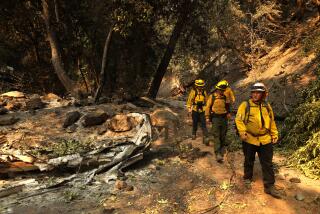The bridge over nothing
It’s a bridge that has been disguised as a street for six decades.
True, it carries a sign that warns drivers not to carry overly heavy loads “on this bridge.” But UCLA’s Dickson Court bridge looks like just another road passing through, not over, an area of rolling lawns on the east side of campus. Students sit on its guardrails without fear because there is no drop.
Few know that the drop once was a five-story-deep ravine. The bridge, erected in 1927 with picturesque Romanesque arches, was known as Arroyo Bridge and was the first structure built at UCLA. Truckloads of construction materials for the new UC campus were carried over it.
In 1947, the ravine was filled with thousands of cubic yards of dirt, burying the brick-enclosed arches and making way for new buildings.
Passers-by today have just a misleading, tip-of-the-iceberg view.
“Sometimes I’ll tell a new employee I’m going up to the bridge and he’ll say, ‘What bridge?’ ” said Bob Parker of UCLA Facilities Management.
An underground tunnel between the arches is used for storage and connects with other tunnels that hold pipes and power lines.
The passageways still attract unauthorized urban explorers. Spray-painted fraternity names speckle the walls. But modern students weren’t the first visitors.
The history book “UCLA on the Move” tells of a janitor who found a student living under the bridge during the Depression because her father had been wiped out in the stock market crash and could no longer pay her expenses.
“She discovered she could use the women’s gymnasium for her daily shower and sleep under the bridge at night, having made a bed of several planks, a pile of straw and blankets,” wrote authors Andrew Hamilton and John B. Jackson.
Perhaps it was that woman’s experience that prompted a short-lived drive in 1937 to turn the space under the bridge’s spans into a dormitory for undergraduates.
“You couldn’t ask for a stronger type of bridge,” one proponent told the L.A. Times that year. “All of that room . . . might just as well be put to good use.”
The space attracted attention again during World War II.
“Below where the bridge is, enough food was stored for 50,000 people if we were bombed,” an alumnus was quoted as saying in the Daily Bruin in 1998. “People were very frightened of a Japanese submarine attack.”
In 1967, the tunnels in the bridge area were used as a getaway route for George Lincoln Rockwell, the head of the American Nazi Party, after a speech at nearby Royce Hall.
Tour groups don’t get to see the underground part of the bridge, but you can relive an unauthorized 1998 expedition on the website https://www. fortunecity.com/lavendar/hitchcock /333/.
And because of the many ancient power connections down there, the tunnels hold more than one mystery.
“Sometimes,” Parker said, “we’ll find a line that has been cut off, and no one knows where it was supposed to go or what it did.”
Water sometimes trickles through the tunnels, a sign that the stream that once was visible at the bottom of the arroyo may have been buried but hasn’t gone away.
And then there’s the weight-limit sign on the surface. It’s no novelty.
“The bridge still has to meet earthquake standards and go through all the inspections by the state of California,” Parker said. “It’s still a bridge.”
No matter what anyone says.
--
More to Read
Sign up for Essential California
The most important California stories and recommendations in your inbox every morning.
You may occasionally receive promotional content from the Los Angeles Times.










